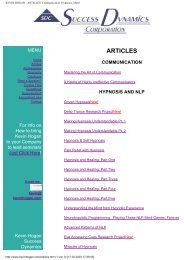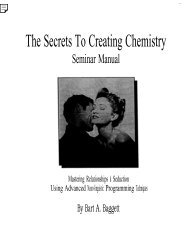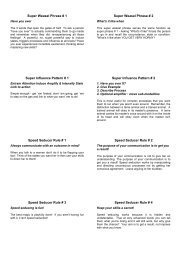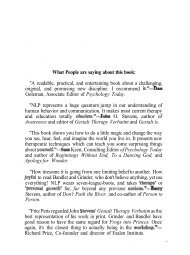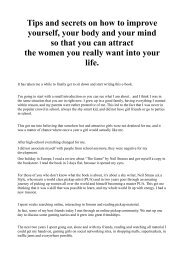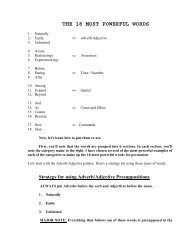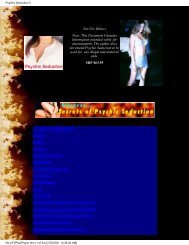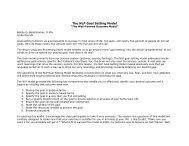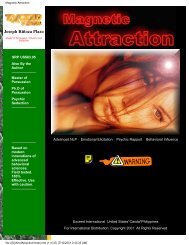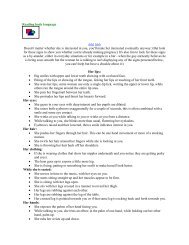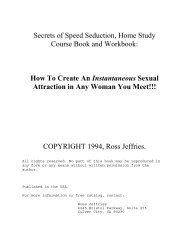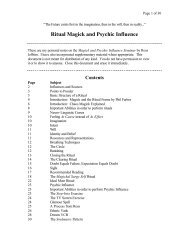A Pragmatic Guide To Communication & Change.pdf - NLP Info Centre
A Pragmatic Guide To Communication & Change.pdf - NLP Info Centre
A Pragmatic Guide To Communication & Change.pdf - NLP Info Centre
- No tags were found...
Create successful ePaper yourself
Turn your PDF publications into a flip-book with our unique Google optimized e-Paper software.
times shake the very foundations of his belief systems. It is exciting when people begin to<br />
understand that they do have control in situations where they thought they didn't, and they<br />
can actually change their thoughts, feelings and behaviors. However, the sudden<br />
realization of this additional responsibility may also be uncomfortable or even traumatic<br />
to some. Be prepared to provide additional support and understanding to people who<br />
begin to make dramatic changes in themselves and their models of reality.<br />
97<br />
had been made. As it was in her case, it can be important to challenge this generalization.<br />
This enables a person to discover how his model limits his experience of the world in<br />
ways that may be causing undue pain. In the illustration below, the man is so wrapped up<br />
in his particular frame of mind that he rune the risk of failing to perceive the happy wthe<br />
welcome by his beautiful, healthy family. This isatypistocalrteodf ay universal quantifiers<br />
can be indicative of di<br />
model of the world.<br />
By helping a speaker to recognize that such a statement is a generalization that is not<br />
necessarily based on reality, you begin the process of expanding and changing those<br />
perceptions that limit and cause the person to suffer needlessly. The Meta Model response<br />
to phrases which include words like "always," "never," "all," "nothing ever," etc- is to ask<br />
the speaker if lie is aware of any contradictions to his statement. Another effective<br />
response is to repeat his statement while exaggerating with your voice the universal<br />
quantifiers in order to demonstrate the absurdity or impossibility of the statement. Some<br />
examples are:<br />
94<br />
Response:<br />
Speaker:"I never do anything right"<br />
Can you think of a time when you did something right?"<br />
Speaker:"Everybody's mean to me."<br />
Other words which imply a lack of choice or indicate the speaker's lack of awareness of<br />
his participation in and responsibility for his feelings and actions are: "must," "have to,"<br />
"ought to," and their opposites, "shouldn't," "must not," etc. Examples of this Meta Model<br />
violation are:<br />
Speaker: "I must never say those things." Response: "What will happen if you do?"<br />
"Shoulds" are often heard when one person is blaming another: "You should know better<br />
than that!" This pattern is typical of someone operating out of the visual model, especially<br />
under stress. In this way, a "visual" can verbally externalize his frustration or anger at a<br />
person or situation and at the same time exclude himself from having any responsibility<br />
for the situation.<br />
L-fl modal operator of possibility is another indicationofA potentially counterproductive<br />
limitation on a person's model<br />
9.5<br />
Of the world. When a person says "I can't," he is talking about something he perceives as<br />
being outside his ability or sphere of influence. However, it is often simply the person's<br />
perception which is limiting, not his ability or the environment or the situation. In the<br />
illustration below, for example, the first boy's initial statement followed by his<br />
catastrophic expectation is a demonstration of a limit on his model of the world that<br />
prevents him from even attempting to get what he wants.



